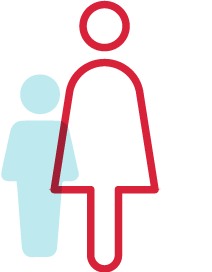

"Provide all staff from the CEO to customer service operators with financial abuse and family violence awareness training. Provide referral pathways for financial counselling and family violence specialist services. Invest in financial literacy programs and work collaboratively with community sector organisations."
-
 15.7%of women have experienced financial abuse.
15.7%of women have experienced financial abuse. -
 Financial abuse is themost commonform of elder abuse.
Financial abuse is themost commonform of elder abuse. -
 Financial abuse costs the economy$15.6 billionevery year.
Financial abuse costs the economy$15.6 billionevery year. -
 Two thirdsof women affected by family violence are working.
Two thirdsof women affected by family violence are working.
Financial abuse is a systematic behaviour where one person tries to control another person’s access to money. This kind of abuse often occurs between partners or other family members. Financial abuse is a form of family violence, and can be present with other forms of abuse, like physical or emotional abuse, but can also be present without these other behaviours.
There are a lot of different ways someone can be financially abusive towards a family member. Some forms of financial abuse may even seem like displays of affection, like one family member offering to take control of the finances to take the pressure off another, but are really an attempt to control their access to money. Financially abusive behaviour can take many different forms such as controlling a family member's money, stopping them from being financially independent or earning their own money.
Financial abuse as a form of intimate partner violence
Financial abuse commonly occurs in romantic relationships. It can occur throughout a relationship, or may begin after separation through things like property settlement and child support processes. Like other forms of intimate partner violence, financial abuse is highly gendered, with the majority of victims being women. However, financial abuse can occur in any relationship, regardless of the gender of the people in that relationship. Women with disabilities are at a higher risk of experiencing financial abuse. Financial abuse, like other forms of family violence, is a pattern of behaviour used to control the life of the victim.
Elder abuse
Financial abuse of an older person is also a form of family violence called elder abuse. It is most commonly perpetrated by the older person’s adult child, and can occur with or without other forms of abuse. Financial abuse, along with emotional abuse, is one of the most common forms of family violence perpetrated against older people, with both forms of abuse often coexisting.

I was in a financial, mental, physical and sexually abusive relationship for 10 years. I’m a survivor but the scars remain for life.
Bec's story
Financially abusive behaviours
Financially abusive behaviours include:
Controlling a family member’s money:
-
Taking control of someone else’s finances (e.g. being in charge of all the household income and paying the other person an allowance).
-
Controlling how all of the household income is spent.
-
Forcing a family member to claim social security benefits like Centrelink.
-
Making a family member go guarantor on a loan or take a loan out in their name.
-
Making a family member take out a second credit card.
-
Forcing a family member to work in a family business without being paid.
-
Filing fraudulent insurance claims.
-
Forging a family member’s signature on financial documents.
-
Taking money out of a family member’s pension.
-
Selling a family member’s possessions without permission.
-
Misusing an Enduring Power of Attorney.
-
Forcing a family member to change their will.
Stopping a family member from earning their own money:
-
Stopping a family member from getting a job or going to work.
-
Stopping a family member from going to work or important meetings by keeping them up all night or physically hurting them.
-
Stopping a family member from studying.
-
Stalking or harassing a family member’s colleagues.
Limiting a family member’s access to money:
-
Not giving a family member access to bank accounts.
-
Denying a family member access to money so they can’t afford basic expenses like food or medicine.
-
Destroying, damaging or stealing property.
-
Racking up debt on shared accounts or joint credit cards.
-
Withholding financial support like child support payments.
-
Refusing to work or contribute anything to the household income.
-
Gambling away a family member’s money or shared money.
Warning signs
There are a number of behaviours that may be present during an interaction if one of your customers is experiencing financial abuse. These include:
- Taking instructions from someone else.
- Being withdrawn or silent during appointments.
- Appearing fearful of the other person.
- Confusion on the purpose of a loan or product.
- Being unaware of products in their name.
- A co-borrower not being present at appointments.
- Mentioning that an intervention order is in place.
- Expressing concerns about privacy.
- If a person does not have access to account information.
- Someone mentioning they are not allowed to work or study.
Red flags of financial elder abuse include:
- Reluctance to make a will.
- Loss of jewellery and personal property.
- Unprecedented transfer of funds.
- Improper attainment, or misuse of a Power of Attorney or Enduring Power of Attorney.
- Loss of financial material e.g. bank books, credit cards, cheque books.
- Bills not paid when money entrusted to a third party.
- Management of a competent person's finances by another person.
- Sudden inability to pay bills, rent, buy food or participate in social activities.
- Unexplained withdrawal from bank accounts.
- Cashing of personal cheques.
- Removal of cash from a wallet.
The effects of financial abuse
Financial abuse can have huge effects on a person’s life, that are not just limited to their financial wellbeing, including impacts on their social inclusion, housing security, physical and mental health. The ramifications of financial abuse are multifaceted and complex, something to keep in mind when working with a client experiencing abuse.
Financial abuse can result in large amounts of debt accrued in the person experiencing abuse’s name, which can be accumulated in a number of different ways. For example, debts can be accrued through joint loans or credit cards, loans the abuser forced the victim to apply for, loans the abuser forged the victim’s signature, and second credit cards linked to the victims account.
Financial effects are not just limited to debts, financial abuse can also play a large role in a survivor’s access to income. For example, if an abuser forces someone to stop working they can become socially isolated and find it extremely difficult to rejoin the workforce. Financial abuse can create an added barrier to leaving an abusive relationship, with survivors being financially dependent on their abuser and not being able to cover costs associated with leaving such as housing. This means survivors who do leave can end up living in insecure or unsafe housing, refuges or experience homelessness.
The effects of financial abuse can also impact on a survivor’s health and well-being, as they may be unable to access health care due to a lack of financial resources or the controlling behaviour of an abuser. Mental health issues can also arise due to the financial abuse, particularly if the survivor is socially isolated or experiencing emotional or physical abuse.
Financial abuse can affect all aspects of a person’s life, so it’s important to remember that your client may have many different needs, and may need to be referred to other services. To find out more about helping a client experiencing financial abuse, go to our topic on how to support someone experiencing family violence.


